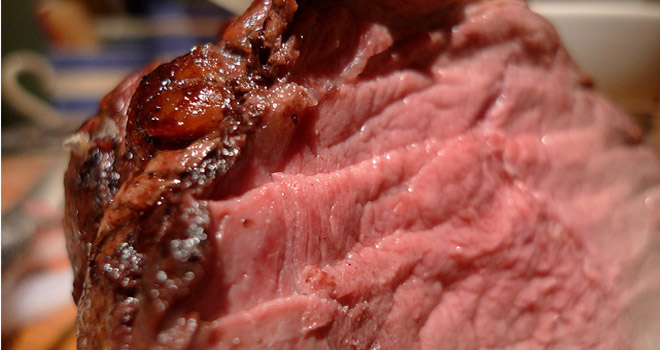By Emily Gertz
That chicken breast or pork loin sitting on your plate may look innocent enough — yet meat production is among humanity’s most environmentally destructive activities.
It is estimated that livestock raised for meat drink up eight percent of the fresh water supply, create 18 percent of global greenhouse gas emissions, and use about 30 percent of the world’s non-ice-covered land. Clearing land for livestock is also a major driver of the destruction of forests and other wildlife habitat.
Enter “cultured meat,” or meat grown “in vitro:” beef, sheep, and other animal muscle cells grown in laboratories, using the well-established tissue cultivation method of immersing a few cells in a nutrient-dense glop, and then leaving them alone to divide and increase.
Proponents say that cultured meat could feed billions cheaply. It could be grown in any shape, and even texturized to improve palatability: Sheets of meat cells could be stretched mechanically, imitating how an animal uses its muscles.
Cultured meat has been a gleam in the eye of futurists and scientists for decades.
During the first half of the 20th century, French surgeon (and accused Nazi collaborator) Alexis Carrel kept a culture of chicken heart cells alive for over 20 years. Carrel’s success inspired sci-fi author Frederick Pohl to dream up “Chicken Little,” a perpetually-growing factory food involving cultured meat cells, in his 1952 novel The Space Merchants.
But for now, meat cultivation remains experimental. New Yorker writer Michael Specter recently reported that “so far, the largest piece of ‘meat’ that has been produced” by one major research effort “measured eight millimeters long, two millimetres wide, and four hundred microns thick…[it] was about the size of a contact lens.”
Nonetheless, test tube meat has enormous potential to curb meat production’s environmental harms, presumably while keeping us supplied with steaks and cutlets, according to research newly published in the journal Environmental Science & Technology.
Researchers Hanna Tuomisto and M. Joost Teixeira de Mattos of the University of Oxford, and the University of Amsterdam respectively, out to calculate the energy, land, and water use involved in producing 1000 kilograms (around 2,200 pounds) of cultured meat, as well as the greenhouse gas emissions. They used a methodology called “life cycle analysis” to extrapolate from current experiments the resource needs and impacts of commercial scale meat cultivation.
The factors they calculated ranged from how much water and land would be used to cultivate cyanobacteria “feed” for the meat cells, to the energy expended in transporting and sterilizing these feedstocks, to the energy involved in culturing the cells themselves.
They then compared the results to earlier studies on the life-cycle impacts of “conventional” meat production: beef, sheep, pork, or poultry grown on the hoof or claw.
Tuomisto and de Mattos found that overall, growing meat in laboratories proved much more efficient and less polluting than conventional methods, particularly for beef.
According to their results, culturing meat decreased water use by 82-96% and greenhouse gas emissions by 78-96% compared to traditional livestock farming, while land use impacts dropped by 99 percent. Only poultry required less energy than lab-grown meat to produce the same amount.
It may seem obvious that removing the resource and cost-intensive animal husbandry piece of the equation would reduce pollution, and sharply cut the amount of water, land, and energy necessary for producing meat. But proving it with peer-reviewed hard data may help encourage risk-averse investors to back the idea.
From an ecological perspective, it can’t happen fast enough. Globally, meat consumption is on track to double during the first half of this century, as the population heads for eight billion by 2050.






